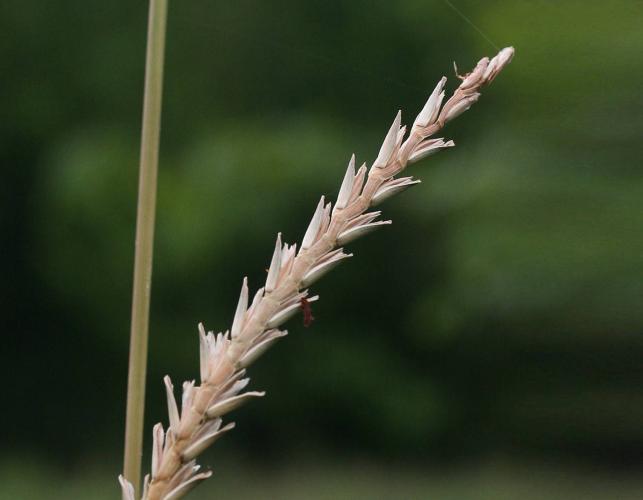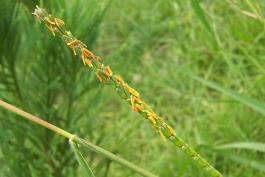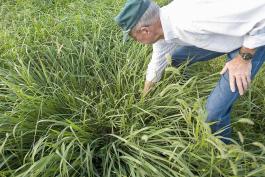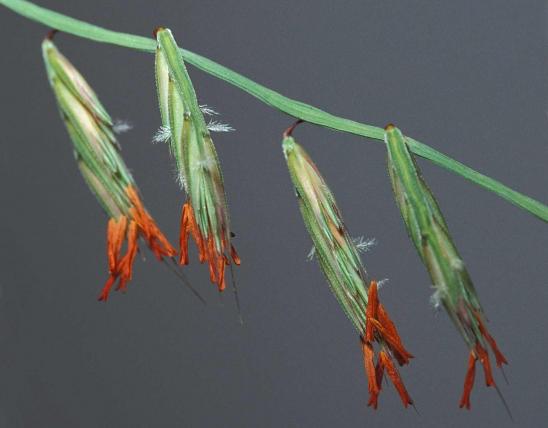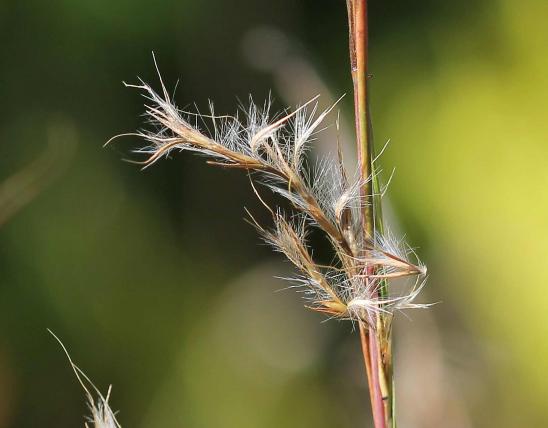
Eastern gama grass is a native perennial bunch grass with flowering stalks up to 8 feet tall. It grows from short, stout rhizomes, and its clumps can be 4 feet wide. The leaf blades have a thickened midvein, can be about ¾ inch wide, and reach about 2 feet long. The flower heads comprise 1–4 fingerlike spikes (seed heads), each up to about 10 inches long, upright and narrowly cylindrical, that arise from the tip of the stem. The male and female flowers are separated, with the seed-bearing, female florets in the bottom half or third of each spike, and the male, pollen-bearing florets occurring in pairs at the top. The male portion of the spike often falls off as an intact unit, while each seed that forms in the female portion of the spike falls off individually. The female florets are closely appressed to the stalk and appear sunken into it. Flower heads develop May–September.
Similar species: Gama grass’s relatively close relationship to the wild ancestor of cultivated corn, or maize (Zea mays), can be seen in several characteristics they share, including the separate male and female flowers, the large size of the plant, the enlarged, white midveins in the leaves, the linear flower spikes with sessile (unstalked) florets, and the warm-season photosynthetic metabolism. Cultivated corn, however, is an annual, not a perennial, and its “cob” structure prevents it from being able to fertilize itself without human assistance. Therefore, any corn plants encountered growing outside of cultivation won’t persist.
Height: flowering stems 2–8 feet
Scattered statewide, most abundant in the glaciated plains north of the Missouri River. It is found throughout much of the eastern and central United States.
Habitat and Conservation
Occurs in upland prairies, glades, savannas, and less commonly openings and margins of mesic to dry upland forests; also along roadsides and railroads, in fallow fields, in margins of crop fields, and in disturbed, open areas. Eastern gama grass is an important component of native upland prairies and glades. Like most other prominent tall grasses of tallgrass prairies (such as big bluestem), eastern gama grass is a warm-season grass that photosynthesizes most efficiently during the hottest part of the summer, a time when cool-season grasses may go dormant.
Status
Within the large and diverse grass family, eastern gama grass is included in the same tribe as corn, sorghum, big bluestem, Indian grass, little bluestem, and silver grass (Miscanthus — an Asian grass popular in landscaping). The curious word “gama” apparently is derived from the word “grama,” the name used for grasses in genus Bouteloua.
Human Connections
This tall, leafy grass is remarkably productive. Eastern gama grass is considered highly desirable both as fodder for livestock and production of hay, and it is cultivated for these purposes. Cattle relish it, and in many places where this grass historically grew, overgrazing by cattle caused its disappearance because repeated close cropping removes its energy stores and hampers it ability to regrow.
Some researchers have suggested that long, long ago, hybrids between gama grass and the wild ancestor of cultivated corn may have played an important role in the prehistoric origins of cultivated corn. Corn, of course, is one of the most important crop plants in the world, and continuing improvements in cultivated corn may include hybridization with gama grass and perhaps other relatives.
Ecosystem Connections
Historically, elk and bison grazed on this highly nutritious grass. Because their wild herds were not fenced in and roamed freely over a vast range, they generally did not regraze any particular area before the grasses had time to recover and renew growth.
The maze of spaces between the large clumps of gama grass, covered above by the outward-arching foliage, provides valuable cover, shade, and nesting habitat for many native prairie species, including bobwhite, prairie-chickens, and other birds and small mammals.



